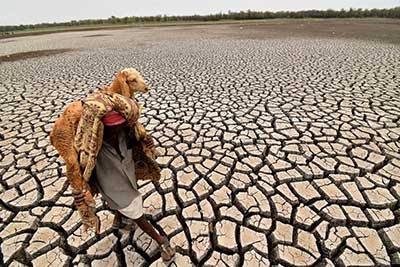Date: 02/03/2023
Relevance: GS-3: Conservation, environmental pollution and degradation, environmental impact assessment.
Key Phrases: US National Oceanic and Atmospheric Administration (NOAA), Climate Change, Food Security, El Nino, La Nina, El Nino-Southern Oscillation (ENSO), Indian Ocean Dipole, Crop Weather Watch Group
Why in News?
- The US National Oceanic and Atmospheric Administration (NOAA) has reported that the equatorial Pacific Ocean will return to its neutral state between March and May of 2023, and it is likely that El Niño conditions will develop during the northern hemisphere’s autumn and winter.
What is El Nino?
- The Pacific Ocean and its seasonal climate cycles represent a massive jigsaw puzzle, of which El Nino is one piece.
- The Pacific ocean holds 97 per cent of the total water on the planet; accounts for 78 per cent of global ocean precipitation; and is the source of 86 per cent of global evaporation.
- Being the largest single body of water, the Pacific has an outsized influence on weather and climate across the globe.
- In normal conditions, trade winds here blow West along the Equator, pushing warm water from South America towards Asia.
- To replace that warm water, cold water rises from the depths.
- El Niño and La Niña are opposing climate patterns that break these normal conditions and collectively represent the El Nino-Southern Oscillation (ENSO) cycle.
El Nino Southern Oscillation (ENSO):
- Every two to seven years, the equatorial Pacific Ocean gets up to 3°C warmer known as an El Niño event or colder than usual known as La Niña triggering a cascade of effects felt around the world.
- This cycle is called the El Niño Southern Oscillation (ENSO) because every El Niño is naturally followed by a La Niña and vice versa, with some months of neutral conditions in between events.
- The change in sea surface temperature associated with ENSO events might seem marginal, but it is more than enough to disrupt weather patterns globally and even the large-scale circulation of air in the polar stratosphere 8km above the Earth.
How does an El Nino impact rainfall?
- During El Niño, trade winds weaken and warm water gets pushed back East of the Pacific, towards the West coast of the Americas.
- Warm oceans promote evaporation and therefore lower pressure, causing air and moisture to ascend.
- The moisture condenses in the heights to form clouds, storms, heavy rain and floods.
- The exact reverse happens at the other end (Asia) where waters become cooler.
- Air descends here and builds pressure, setting up clear skies and below-normal rainfall.
- This seasonal fluctuations of pressure/temperature in the ENSO cycle can typically last nine to 12 months; even for years as evidenced in a three-year-long and ongoing (though fading) La Nina.
- On average, these episodes occur every two to seven years but there is no regular pattern.
What is the probability of 2023 being an El Nino year?
- Generally, El Niño occurs more frequently than La Niña.
- Most global models predict enhanced possibilities of the current La Nina ending sooner than later, and the Pacific shifting into an El Nino mode from this summer (2023) coinciding with the South-West monsoon in India.
- As per India Meteorological Department (IMD), a clearer image would emerge only in April which will reflect in its first long-range forecast for the June-September South-West monsoon.
Indian Ocean Dipole:
- Forecasters must also take into account the state of the Indian Ocean.
- The Indian Ocean Dipole, which is produced by this ocean significantly and more closely resembles the ENSO cycle.
- When temperatures increases and pressure lowers down in the West Indian Ocean, it is called a positive IOD, which boosts a concurrent Indian monsoon, and vice versa.
- The average of forecasts from international models, according to the Australian Bureau of Meteorology, point to a favourable IOD beginning in July (with the caution of the spring barrier). This could neutralise the adverse effects of an El Nino on the monsoon.
How will El Nino impact agriculture output in India? Which crops will be most affected?
- El Nino will typically lead to drought.
- In the past, El Nino has resulted in drought or deficient southwest monsoon in the country.
- A deficient monsoon could affect the production of kharif crops.
- In the event of a severe El Nino, the crops most likely to be impacted include paddy, a water guzzler, groundnuts, and pulses. Cotton and sugarcane production may also suffer.
Is India prepared to face El Nino? What can the government do to shield the economy?
- India is often ready for such occurrences.
- This is especially true given that it has a Crop Weather Watch Group that keeps an eye on everything from rainfall to crop planting to the amount of water stored in large reservoirs.
- In the past, the government had asked growers to shift to coarse cereals from paddy due to deficient rainfall.
Way Ahead:
- To shield the economy, the government can ensure the availability of ample foodstocks in its granaries.
- It has already procured 47 million tonnes (mt) of the targeted 52.1 mt of rice this crop year to June.
- It will likely procure wheat from April 1 once wheat begins arriving in the markets after harvest.
- The other measures the Centre could resort to are export curbs to ensure adequate domestic supplies.
- El Nino often hurts oil palm production although projections of record-high mustard production and a healthy supply of soyabeans may assist farmers withstand any such crisis.
Source: The Hindu BL
Mains Question:
Q. The US National Oceanic and Atmospheric Administration (NOAA) has reported that El Niño conditions will develop during the northern hemisphere’s autumn and winter. Evaluate its impact on the Indian economy. (150 Words).







